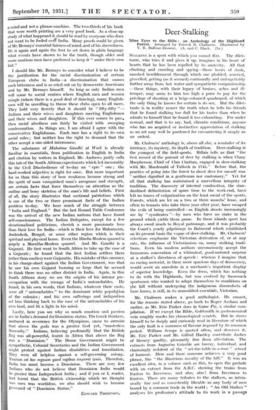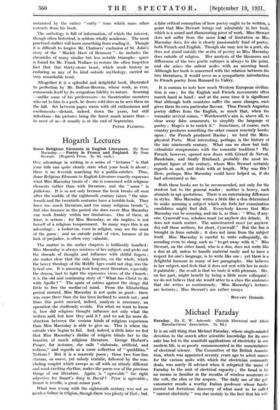Deer-Stalking
STALKING is a sport with which you cannot flirt. The dilet- tante, who tries it and gives it up, imagines in his heart of hearts that he has been repelled by its austerity. All that climbing and crawling and spying—those hours of dank, numbed bewilderment through which one plodded, scurried, grovelled, getting (as it seemed) continually and unforgettably further away from hot water and sympathetic companionship —these things, with their legacy of bruises, aches and ill- temper, may seem to him too high a price to pay for the privilege of shooting at a beige-coloured quadruped, of which the only thing he knows for certain is its sex. But the dilet- tante is in reality nearer the truth when he tells his friends that he found stalking too dull for his tastes than when he admits to himself that he found it too exhausting. For under normal, and that is to say, bad, climatic conditions, anyone who has no acquired or instinctive appreciation of stalking as an art may well be pardoned for encountering it simply as an ordeal.
Mr. Chahners' anthology is, above all else, a reminder of its intricacy, its mystery, its depth of tradition. Deer-stalking is the youngest of the field-sports. Millais tells us that " the first record of the pursuit of deer by stalking is when Cluny Macpherson, Chief of Clan Chattan, engaged in deer-stalking with Mr. Macdonald of Tulloch in 1745." Before that, the practice of going into the forest to shoot deer for oneself was
neither dignified in a gentleman nor customary." Yet for all that stalking has maintained a marvellous integrity of tradition. The discovery of internal combustion, the stan- dardized delimitation of spare time to the week-end, have left no traces of vulgarization on the least social of the sports. Forests, which are let on a two or three months' lease, and often to tenants who take them year after year, have escaped the evils of being controlled—as English shoots increasingly arc by " syndicates "—by men who have no stake in the ground which yields them game. In these islands sport has always owed much to Royal patronage, and it was probably the Court's yearly pilgrimage to Balmoral which established on its present basis the vogue of deer-stalking. Mr. Chalmers' selections emphasize the Victorian derivation of, or at any rate, the influence of Victorianism on, many stalking tradi- tions. Even his modern authors unconsciously accept the humorous convention of a whimsical, good-natured surprise at a stalker's directness of speech : whereas I imagine that no racing motorist, in these more spacious days of democracy, would scent an anecdote in a mechanic's impatient display of superior knowledge. Even the dress, which has nothing to do with the Highlands, but was evolved by Sassenach sportsmen who wanted to adapt themselves to conditions on the hill without undergoing the indigenous discomforts of bare knees, is still, in its unmodified essentials, Victorian.
Mr. Chalmers makes a good anthologist. He cannot, for the reasons stated above, go back to Roger Ascham and earlier, as Mr. Eric Parker does in Game Pic, a similar com- pilation. If we except the Bible, Goldsmith in gastronomical vein roughly marks his chronological scratch. But he shows himself to be deeply and curiously read in literature of which the only fault is a sameness of flavour imposed by its common period. William Serape is quoted often, and deserves it. Mr. Eric Parker and Mr. Gilfrid Hartley contribute dashes of literary quality, pleasantly free from affectation. The extracts from Augustus thimble are breezy, individual, and charmingly redolent of the " set-the-table-in-a-roar " school of humour. here and there someone achieves a very good phrase, like " the illustrious cavalry of the hill." It was an excellent idea, in a volume such as this, to open the prelude with an extract from the A.B.C. showing the trains from Euston to Inverness, and also, alas ! from Inverness to Euston. There are many tributes to the stalkers, as intrin- sically fine and as consistently likeable as any body of men bound by a common trade in the world ; " An Old Stalker " analyses his profession's attitude to its work in a passage
untainted by the rather " catty " tone which mars other extracts from his book.
The anthology is full of information, of which the interest, though often historical, is seldom wholly academic. The most practised stalker will learn something from reading it. Though it is difficult to forgive Mr. Chalmers' exclusion of St. John's story of the " Muckk Hart of Benmore "—he includes the chronicles of many similar but less notable triumphs—space is found for Mr. Frank Wallace to restate the often forgotten fact that this thirty-stone beast, which made history as enduring as any of its kind outside mythology, carried no very remarkable head.
Altogether it is a splendid and delightful book, illustrated to perfection by Mr. Balfour-Browne, whose work, as ever, commends itself by its scrupulous fidelity to nature. Scorning —unlike some of his predecessors—to theatricalize monsters who sat to him in a park, he draws wild deer as he sees them on the hill. Set between pages warm with old enthusiasms and excitements—distant, indeed, down the years, but still infectious—his pictures bring the forest much nearer than— to most of us—it usually is at the end of September.
PETER FLEMING.



































 Previous page
Previous page